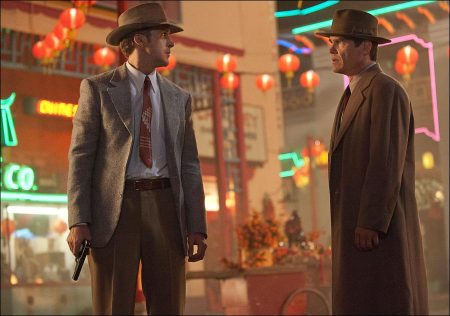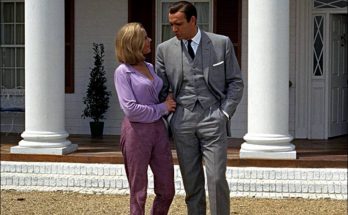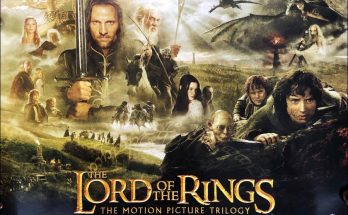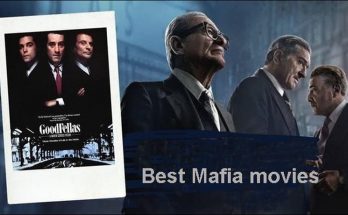Gangster Squad: Suiting up and dressing down. Costume designer of “Gangster Squad” Mary Zophres was eager to dig into the period styles. “I think it’s an attraction for actors to sink their teeth into this kind of material, dialogue-wise and action-wise, but also because of the way it all looked. It’s hard to make somebody look bad in those clothes.”
To distinguish between the cops and the mob, Zophres started at the top: Mickey Cohen. “Textured wool was very popular at the time, but Ruben and I thought it would be interesting to have Mickey go against the grain, so his clothing is all very slick, like you could slide right off of it. And while the Gangster Squad is in warm tones and browns, he’s always in cool tones, blues and grays, or a sort of maroon color.”
Zophres strayed a bit from her research on the real man. “We took cues from him, naturally — the long collars that he wore, having his initials on things — but in the photographs we saw that even when he’d have on a new suit, he always looked a bit of a mess. Nevertheless, we wanted Sean to appear fierce and striking and always put together.”
With respect to those initials, she adds, “You don’t necessarily see them on camera, but they’re in his pockets or on his boxers or his cufflinks. In a subtle way, he’s broadcasting who he is in that world he lives in. Also, the real Cohen never wore the same suit twice, and neither does Sean.” To create a contrast with Mickey’s lighter-colored shirts, the designer put his crew in all dark colors, so Cohen would stand apart even more.
Arguably the most eye-catching accessory Mickey Cohen wears is the dame on his arm, Grace Faraday. “Obviously, Grace has a very rich boyfriend who buys her gowns,” Zophres smiles. “I felt like her everyday dresses were things she had before she met him, and they were simpler, but her eveningwear and jewelry are things he got for her.”
For Emma Stone, those gowns came at a price, so to speak. “Emma’s got a great structure to begin with, but in order to give her the hourglass figure of a Vargas girl, as described in the script and very much in vogue at the time, we manipulated her a bit,” Zophres reveals. “We added a more prominent bust line to make her curvier, and put her in a corset that shrank her waist by about three inches. I think she was very happy to take those costumes off at the end of the day.”
When Stone first appears in the movie, she’s resplendent in Zophres’ favorite piece. “I love that red gown; it’s a showstopper. Nobody is as glamorous in this movie as Grace, and it was so much fun to see this dress go from the sketch to the finished piece. And Emma truly does it justice.”
“That red dress that Mary made from scratch is so beautiful and elegant, and Emma looked so striking in it,” Fleischer agrees. “When she first walked across the set, with the slit showing her leg and the dramatic scarf around her neck… And then there’s a two-shot of her and Wooters at the bar, where we cut to the back and you see this sort of portrait of her. She just looked absolutely stunning.”
Stone credits Zophres, as well as her hair and makeup team, with her transformation. “We all brainstormed, and came up with a hodgepodge of a lot of ’40s movie stars. She has the teeth of Vivien Leigh, the hair of Gene Tierney, Lauren Bacall’s makeup and, well, all of it is Rita Hayworth,” Stone laughs. “But I think that’s what Grace did, too. A lot of those ingenues did it. And since Grace wanted to be a star, I think she pieced together all the women she found beautiful and tried to be all of them at once. Unfortunately, it didn’t work out, career-wise, because she’s not all of them…or any of them.”
For the cops, Zophres immediately distinguished them from the mobsters by one simple factor: “The gangsters are mostly in double-breasted jackets and the good guys are in single-breasted cuts.” She and her team also strove to give each member of the squad a distinct look, starting with O’Mara. “He’s a war veteran and comes from being a uniformed cop, so, to my mind, he doesn’t care about how he looks; he’s just there to do a job. He knows that as a detective he needs to be in a suit, and we gave him five or six, but nothing fancy that draws attention. As he goes through the movie, you can hardly tell the difference between them.”
Unlike Jerry Wooters, whom Zophres describes as “a total clothes horse who spends all of his disposable income on his wardrobe. He definitely cares about how he looks.”
“I loved the way Mary contrasted the two,” Fleischer says. “O’Mara’s suits are utilitarian, evocative of his past as a soldier, in greens, olives and browns. Wooters is much more stylish; he’s the only member of the squad with pinstripes. He’s a dashing guy and Ryan really looked the part.”
To play gunslinger Max Kennard, Robert Patrick was dressed in a three-piece suit, but with a Western vibe, and instead of wearing the jacket over his vest, he dons a long overcoat. As his young protege, Navidad Ramirez, Michael Pena wore a cobbled-together wardrobe intended to look as if the recent academy graduate had borrowed items from his dad. Giovanni Ribisi was dressed as part suburban family man, part nerd, to play Conwell Keeler.
For Anthony Mackie’s character, Coleman Harris, Zophres found inspiration in an unexpected source: baseball legend Jackie Robinson. “Going through the research, it struck me that there were not a lot of African Americans in the police force in 1949, and that made me think of Robinson and his early days in major league baseball. Out of uniform, he was conservatively dressed but always looked nice, which is what I decided to do with Harris.”
One of Zophres’ greatest delights was designing the looks for the extras. “I love dressing the background,” she says. “You come up with a palette for the movie and a concept for each scene, pull the right stock for every set piece, and when each face walks in the door, you instantly know what to do with them. I have an amazing crew who work their butts off, and by the time the fittings and the alterations and the dyeing and tweaking are done and they’ve gone through hair and makeup, you have this wonderful tableau of complete characters.” In all, Zophres and her department created more than 3,500 costumes.
Fleischer raves, “The level of detail and authenticity, the way the characters are expressed through their clothes and every single extra was brought to life, was just perfect. The work that Mary and her team did was unparalleled.”
Related Link: View the Full Production Notes for Gangster Squad
Views: 100




